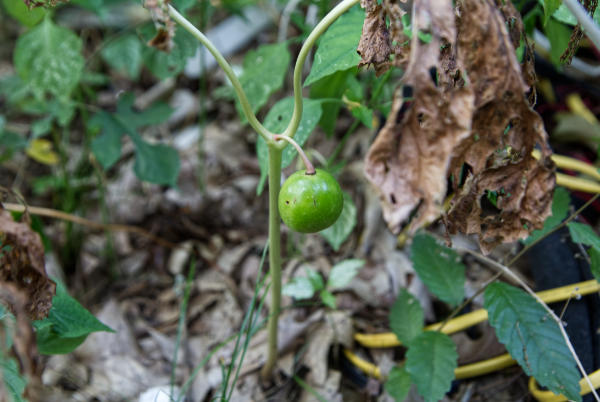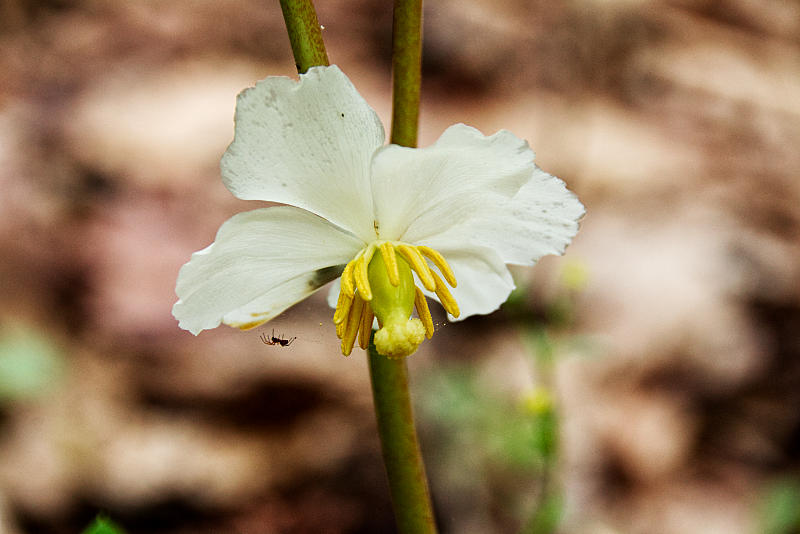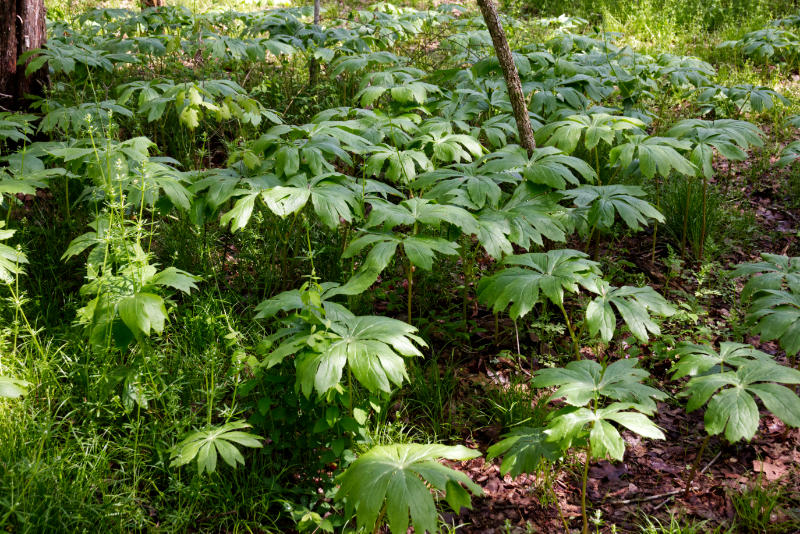
Mayapple: the name may sound innocent, but this plant is hiding a secret. For most of the year, it lays dormant, like a bear in hibernation. But when spring rolls around, the Mayapple bursts forth from the forest floor with a burst of energy, sporting a giant green umbrella-like leaf and a single white flower. But that’s not all – this plant is more than meets the eye. In this article, we’ll dive into the fascinating world of the Mayapple, exploring its unique properties, uses, and hidden dangers. So, why should you keep reading? Because the Mayapple is more than just another pretty face – it’s a botanical powerhouse with a story to tell.
What is Mayapple?
The Mayapple (Podophyllum peltatum) plant gets its common name from the fact that it blooms and sets fruit around May every year. They are widespread in the Eastern US in plant zone 3-8. They are usually encountered in large colonies in the spring before they go dormant during the summer heat.
The leaves remain curled around the stem until the plant is almost to its full height before they unfurl. The stems may produce a single leaf or two leaves.
The reason they are found in colonies is due to the fact they grow from an underground rhizome. You may remember the term rhizome from our article and videos on Cutleaf Toothwort. The rhizome which Mayapple plants arise from in the spring is shallow and creeps just underground through the rich soil created by the leaves which fall and decay on the forest floor.
Individual plants arise from buds on the rhizome and grow to 12-18 inches tall on a single stem. The plants may have 1 but no more than 2 umbrella-like leaves. Some plants produce a single leaf while others branch and grow 2 leaves. Hiding under the leaves is a surprise.
The Mayapple plant will produce a single flower. Only plants that develop 2 leaves will flower. The flower arises from the bifurcation of the stem where the leaves form. They are usually hidden from view when looked at from above.

The flowers can be white to rose-colored and can be 2-3 inches in diameter. They are showy but short-lived. The flowers are an important early-season food source for long-tongued bees such as bumblebees.
Flowers that are pollinated will produce a single oval to lemon-shaped fruit during the summer. These fruits are used by some to make jelly or jams. However, the rest of the plant, including the seeds, is toxic.
Mayapple is Toxic

All parts of the plant except the fruit contain a substance known as podophyllotoxin. This toxin is produced by all parts of the plant but is extracted for use from the roots and rhizomes, which contain the highest concentrations of the toxin. Even the seeds contain this toxin.
The extract is used commercially to create medicine. It has the effect of stopping both cellular and viral DNA from replicating. It is classified as an antimitotic drug. It is used to treat some forms of cancer and is also used in creams as an antiviral agent to treat warts, such as venereal warts.
Some reports even suggest you can absorb the toxin by simply handling the plant or the fruit. It can be toxic to pets if they are exposed to or consume parts of the plant. It can induce vomiting, diarrhea, or drooling in dogs and can also cause skin irritation from contact with the leaves.
There are some animals that may eat the fruit of the Mayapple without ill effects. These include box turtles, opossums, raccoons, and skunks.
Conclusion
Now that you can recognize the Mayapple you will know to avoid it due to its toxicity to humans and other animals. Although the fruit when ripe isn’t considered poisonous I’ll be avoiding this plant entirely.
This is a plant that is easily recognized when you have learned its characteristics.
FAQs:
Q: Is mayapple invasive?
A: No, Mayapple is not considered invasive. It grows naturally in certain regions of North America, and while it can spread over time, it generally does not pose a threat to other plant species.
Q: Are mayapple plants poisonous?
A: Yes, the entire mayapple plant is poisonous, with the exception of the ripe fruit. The plant contains a toxin called podophyllotoxin, which can cause a range of symptoms if ingested.
Q: Are mayapple plants good?
A: Mayapple plants have several unique properties that make them valuable in certain contexts. For example, they contain a compound called podophyllotoxin, which is used in some cancer treatments. They also have a long history of use in traditional medicine.
Q: How do Mayapples spread?
A: Mayapples can spread via their rhizomes, which are underground stems that produce new shoots and roots. They can also spread through seeds, which are often dispersed by animals.
Q: Is it safe to touch mayapple?
A: While mayapple plants are poisonous if ingested, they are generally safe to touch. However, it’s always a good idea to wash your hands after handling any plant material, especially if you have an open wound.
Q: What are Mayapples good for?
A: Mayapples have a range of uses, both medicinal and ornamental. They contain a compound called podophyllotoxin, which is used in some cancer treatments. They have also been used in traditional medicine to treat a variety of ailments.
Q: How did Native Americans use mayapple?
A: Native Americans used mayapple for a variety of medicinal purposes. For example, they used it to treat snakebites, remove warts, and alleviate constipation. They also used the fruit as a food source.
Q: Do deer eat Mayapples?
A: Yes, deer are known to eat Mayapples, especially the fruit. In fact, they are one of the main animals that help to disperse the seeds.
Q: Is mayapple toxic to dogs?
A: Yes, mayapple is toxic to dogs, as well as other pets and livestock. If you suspect your pet has ingested mayapple, contact your veterinarian immediately.
Q: Do rabbits eat mayapple?
A: Rabbits may eat Mayapples, but they are not known to be a major consumer of the plant. Other animals, such as deer and rodents, are more likely to eat Mayapples.
Q: What animal eats mayapples?
A: Mayapples are eaten by a variety of animals, including deer, rodents, birds, and insects. The fruit is particularly attractive to animals, as it is one of the few parts of the plant that is not toxic.
Q: What are companion plants for mayapples?
A: Mayapples are typically found growing in woodland environments, and they often coexist with a variety of other plants. Some potential companion plants for Mayapples include ferns, wild ginger, and trillium.